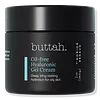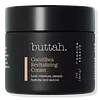What's inside
What's inside
 Key Ingredients
Key Ingredients

 Benefits
Benefits

 Concerns
Concerns

 Ingredients Side-by-side
Ingredients Side-by-side

Water
Skin ConditioningAloe Barbadensis Leaf Juice
Skin ConditioningCyclopentasiloxane
EmollientDimethiconol
EmollientSodium Acrylate/Sodium Acryloyldimethyl Taurate Copolymer
Emulsion StabilisingPropanediol
SolventPropylene Glycol
HumectantCetyl Stearate
EmollientIsostearyl Isostearate
EmollientCetyl Alcohol
EmollientPotassium Cetyl Phosphate
EmulsifyingStearic Acid
CleansingButylene Glycol
HumectantHexylene Glycol
EmulsifyingPolysorbate 20
EmulsifyingGlycerin
HumectantPentylene Glycol
Skin ConditioningSodium Hyaluronate
HumectantAvena Sativa Kernel Meal
AbrasiveNiacinamide
SmoothingAlteromonas Ferment Filtrate
HumectantPhenoxyethanol
PreservativeEthylhexylglycerin
Skin ConditioningXylitylglucoside
HumectantAnhydroxylitol
HumectantXylitol
HumectantCitric Acid
BufferingLactic Acid
BufferingMalic Acid
BufferingGluconic Acid
Ascorbic Acid
AntioxidantGlycolic Acid
BufferingSalicylic Acid
MaskingTartaric Acid
BufferingPanthenol
Skin ConditioningLeuconostoc/Radish Root Ferment Filtrate
AntimicrobialAllantoin
Skin ConditioningTetrahexyldecyl Ascorbate
AntioxidantTocopheryl Acetate
AntioxidantVitis Vinifera Seed Extract
AntimicrobialAlgae Extract
EmollientDisodium EDTA
Water, Aloe Barbadensis Leaf Juice, Cyclopentasiloxane, Dimethiconol, Sodium Acrylate/Sodium Acryloyldimethyl Taurate Copolymer, Propanediol, Propylene Glycol, Cetyl Stearate, Isostearyl Isostearate, Cetyl Alcohol, Potassium Cetyl Phosphate, Stearic Acid, Butylene Glycol, Hexylene Glycol, Polysorbate 20, Glycerin, Pentylene Glycol, Sodium Hyaluronate, Avena Sativa Kernel Meal, Niacinamide, Alteromonas Ferment Filtrate, Phenoxyethanol, Ethylhexylglycerin, Xylitylglucoside, Anhydroxylitol, Xylitol, Citric Acid, Lactic Acid, Malic Acid, Gluconic Acid, Ascorbic Acid, Glycolic Acid, Salicylic Acid, Tartaric Acid, Panthenol, Leuconostoc/Radish Root Ferment Filtrate, Allantoin, Tetrahexyldecyl Ascorbate, Tocopheryl Acetate, Vitis Vinifera Seed Extract, Algae Extract, Disodium EDTA
Water
Skin ConditioningButyrospermum Parkii Butter
Skin ConditioningTheobroma Cacao Seed Butter
EmollientHelianthus Annuus Seed Oil
EmollientPersea Gratissima Oil
Skin ConditioningGlycerin
HumectantOctyldodecanol
EmollientCaprylic/Capric Triglyceride
MaskingRosa Canina Fruit Extract
AstringentCetearyl Alcohol
EmollientPolysorbate 60
EmulsifyingCocos Nucifera Oil
MaskingButylene Glycol
HumectantHyaluronic Acid
HumectantLaureth-3
EmulsifyingStearic Acid
CleansingSteareth-2
EmulsifyingSteareth-21
CleansingPetrolatum
EmollientPolysorbate 20
EmulsifyingPEG/PPG-18/18 Dimethicone
EmulsifyingIsocetyl Stearoyl Stearate
EmollientCarbomer
Emulsion StabilisingDisodium EDTA
Panthenol
Skin ConditioningAllantoin
Skin ConditioningLavandula Angustifolia Oil
MaskingSimethicone
EmollientPhenoxyethanol
PreservativeCaprylyl Glycol
EmollientEthylhexylglycerin
Skin ConditioningCI 19140
Cosmetic ColorantCI 77163
Cosmetic ColorantIron Oxides
Water, Butyrospermum Parkii Butter, Theobroma Cacao Seed Butter, Helianthus Annuus Seed Oil, Persea Gratissima Oil, Glycerin, Octyldodecanol, Caprylic/Capric Triglyceride, Rosa Canina Fruit Extract, Cetearyl Alcohol, Polysorbate 60, Cocos Nucifera Oil, Butylene Glycol, Hyaluronic Acid, Laureth-3, Stearic Acid, Steareth-2, Steareth-21, Petrolatum, Polysorbate 20, PEG/PPG-18/18 Dimethicone, Isocetyl Stearoyl Stearate, Carbomer, Disodium EDTA, Panthenol, Allantoin, Lavandula Angustifolia Oil, Simethicone, Phenoxyethanol, Caprylyl Glycol, Ethylhexylglycerin, CI 19140, CI 77163, Iron Oxides
Ingredients Explained
These ingredients are found in both products.
Ingredients higher up in an ingredient list are typically present in a larger amount.
Allantoin is a soothing ingredient known for its protective and moisturizingg properties. Because of this, it is often added to products with strong active ingredients.
Studies show higher concentrations of this ingredient can promote wound healing.
Though it can be derived from the comfrey plant, allantoin is produced synthetically for cosmetic products to ensure purity.
Learn more about AllantoinButylene Glycol (or BG) is used within cosmetic products for a few different reasons:
Overall, Butylene Glycol is a safe and well-rounded ingredient that works well with other ingredients.
Though this ingredient works well with most skin types, some people with sensitive skin may experience a reaction such as allergic rashes, closed comedones, or itchiness.
Learn more about Butylene GlycolDisodium EDTA plays a role in making products more stable by aiding other preservatives.
It is a chelating agent, meaning it neutralizes metal ions that may be found in a product.
Disodium EDTA is a salt of edetic acid and is found to be safe in cosmetic ingredients.
Learn more about Disodium EDTAEthylhexylglycerin (we can't pronounce this either) is commonly used as a preservative and skin softener. It is derived from glyceryl.
You might see Ethylhexylglycerin often paired with other preservatives such as phenoxyethanol. Ethylhexylglycerin has been found to increase the effectiveness of these other preservatives.
Glycerin is already naturally found in your skin. It helps moisturize and protect your skin.
A study from 2016 found glycerin to be more effective as a humectant than AHAs and hyaluronic acid.
As a humectant, it helps the skin stay hydrated by pulling moisture to your skin. The low molecular weight of glycerin allows it to pull moisture into the deeper layers of your skin.
Hydrated skin improves your skin barrier; Your skin barrier helps protect against irritants and bacteria.
Glycerin has also been found to have antimicrobial and antiviral properties. Due to these properties, glycerin is often used in wound and burn treatments.
In cosmetics, glycerin is usually derived from plants such as soybean or palm. However, it can also be sourced from animals, such as tallow or animal fat.
This ingredient is organic, colorless, odorless, and non-toxic.
Glycerin is the name for this ingredient in American English. British English uses Glycerol/Glycerine.
Learn more about GlycerinPanthenol is a common ingredient that helps hydrate and soothe the skin. It is found naturally in our skin and hair.
There are two forms of panthenol: D and L.
D-panthenol is also known as dexpanthenol. Most cosmetics use dexpanthenol or a mixture of D and L-panthenol.
Panthenol is famous due to its ability to go deeper into the skin's layers. Using this ingredient has numerous pros (and no cons):
Like hyaluronic acid, panthenol is a humectant. Humectants are able to bind and hold large amounts of water to keep skin hydrated.
This ingredient works well for wound healing. It works by increasing tissue in the wound and helps close open wounds.
Once oxidized, panthenol converts to pantothenic acid. Panthothenic acid is found in all living cells.
This ingredient is also referred to as pro-vitamin B5.
Learn more about PanthenolPhenoxyethanol is a preservative that has germicide, antimicrobial, and aromatic properties. Studies show that phenoxyethanol can prevent microbial growth. By itself, it has a scent that is similar to that of a rose.
It's often used in formulations along with Caprylyl Glycol to preserve the shelf life of products.
Polysorbate 20 is made by combining ethoxylation of sorbitan, ethylene oxide, and lauric acid. It is a mild cleansing agent, surfactant, and emulsifier.
As a surfactant, it helps collect dirt and oils for washing. Emulsifiers prevent oils and water from separating.
Polysorbate 20 also adds scent to a product. Since it is made using sorbitol, it has a sweet scent. Sorbitol can also be found in fruits such as apples and peaches.
The lauric acid used to create Polysorbate 20 is often derived from coconuts.
Polysorbate 20 may not be fungal acne safe.
Learn more about Polysorbate 20Stearic Acid is a fatty acid. It is an emollient, emulsifier, and texture enhancer.
As an emollient, stearic acid helps soften skin. It aids the skin's protective barrier by preventing water loss. It also provides a gentle cleansing effect without stripping away natural oils.
Stearic acid may also be used to enhance the texture of products. It can add volume and stabilize ingredients such as water and oil. This can help water and oil ingredients from separating.
Sources of stearic acid include animal or vegetable fats/oils such as coconut or shea. It can be naturally found in butter, cocoa butter, shea butter, vegetable fats, and animal tallow.
This ingredient may not be Malassezia folliculitis, or fungal-acne safe.
Learn more about Stearic AcidWater. It's the most common cosmetic ingredient of all. You'll usually see it at the top of ingredient lists, meaning that it makes up the largest part of the product.
So why is it so popular? Water most often acts as a solvent - this means that it helps dissolve other ingredients into the formulation.
You'll also recognize water as that liquid we all need to stay alive. If you see this, drink a glass of water. Stay hydrated!
Learn more about Water